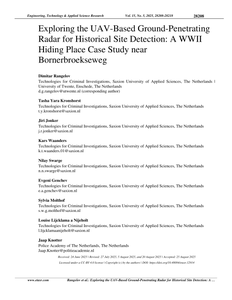Artificial intelligence (AI) integration in Unmanned Aerial Vehicle (UAV) operations has significantly advanced the field through increased autonomy. However, evaluating the critical aspects of these operations remains a challenge. In order to address this, the current study proposes the use of a combination of the 'Observe-Orient-Decide-Act (OODA)' loop and the 'Analytic Hierarchy Process (AHP)' method for evaluating AI-UAV systems. The integration of the OODA loop into AHP aims to assess and weigh the critical components of AI-UAV operations, including (i) perception, (ii) decision-making, and (iii) adaptation. The research compares the results of the AHP evaluation between different groups of UAV operators. The findings of this research identify areas for improvement in AI-UAV systems and guide the development of new technologies. In conclusion, this combined approach offers a comprehensive evaluation method for the current and future state of AI-UAV operations, focusing on operator group comparison.
DOCUMENT
Twirre is a new architecture for mini-UAV platforms designed for autonomous flight in both GPS-enabled and GPS-deprived applications. The architecture consists of low-cost hardware and software components. High-level control software enables autonomous operation. Exchanging or upgrading hardware components is straightforward and the architecture is an excellent starting point for building low-cost autonomous mini-UAVs for a variety of applications. Experiments with an implementation of the architecture are in development, and preliminary results demonstrate accurate indoor navigation
MULTIFILE

Twirre V2 is the evolution of an architecture for mini-UAV platforms which allows automated operation in both GPS-enabled and GPSdeprived applications. This second version separates mission logic, sensor data processing and high-level control, which results in reusable software components for multiple applications. The concept of Local Positioning System (LPS) is introduced, which, using sensor fusion, would aid or automate the flying process like GPS currently does. For this, new sensors are added to the architecture and a generic sensor interface together with missions for landing and following a line have been implemented. V2 introduces a software modular design and new hardware has been coupled, showing its extensibility and adaptability
DOCUMENT

This study evaluates the potential of Unmanned Aerial Vehicle-based Ground-Penetrating Radar (UAV-GPR) for identifying buried features related to a suspected World War II (WWII) hiding place near Bornerbroekseweg, the Netherlands. The survey area is an active farmland field with limited surface indicators and partially documented historical significance. A total of six UAV flight lines and four ground-based GPR paths were conducted to cover the site. Subsurface anomalies were identified at depths between approximately 0.2 and 1.5 m. In particular, Flight 6 revealed a near-surface reflection at 0.2–0.4 m, whereas Flight 4 showed a deeper horizontal anomaly at around 1.2–1.5 m. Ground-based Path 3 supported these findings with continuous horizontal reflections distinct from natural stratigraphy. The integration of UAV and ground-based data enabled full-site coverage and localized resolution, supporting the identification of areas warranting further archaeological investigation. The results demonstrate the applicability of UAV-GPR for non-invasive prospection in rural historical sites with uncertain spatialrecords and suggest its value for informing targeted excavations.
MULTIFILE

This paper introduces a novel distributed algorithm designed to optimize the deployment of access points within Mobile Ad Hoc Networks (MANETs) for better service quality in infrastructure less environments. The algorithm operates based on local, independent execution by each network node, thus ensuring a high degree of scalability and adaptability to changing network conditions. The primary focus is to match the spatial distribution of access points with the distribution of client devices while maintaining strong connectivity to the network root. Using autonomous decision-making and choreographed path-planning, this algorithm bridges the gap between demand-responsive network service provision and the maintenance of crucial network connectivity links. The assessment of the performance of this approach is motivated by using numerical results generated by simulations.
DOCUMENT

Reducing the use of pesticides by early visual detection of diseases in precision agriculture is important. Because of the color similarity between potato-plant diseases, narrow band hyper-spectral imaging is required. Payload constraints on unmanned aerial vehicles require reduc- tion of spectral bands. Therefore, we present a methodology for per-patch classification combined with hyper-spectral band selection. In controlled experiments performed on a set of individual leaves, we measure the performance of five classifiers and three dimensionality-reduction methods with three patch sizes. With the best-performing classifier an error rate of 1.5% is achieved for distinguishing two important potato-plant diseases.
MULTIFILE

This research reviews the current literature on the impact of Artificial Intelligence (AI) in the operation of autonomous Unmanned Aerial Vehicles (UAVs). This paper examines three key aspects in developing the future of Unmanned Aircraft Systems (UAS) and UAV operations: (i) design, (ii) human factors, and (iii) operation process. The use of widely accepted frameworks such as the "Human Factors Analysis and Classification System (HFACS)" and "Observe– Orient–Decide–Act (OODA)" loops are discussed. The comprehensive review of this research found that as autonomy increases, operator cognitive workload decreases and situation awareness improves, but also found a corresponding decline in operator vigilance and an increase in trust in the AI system. These results provide valuable insights and opportunities for improving the safety and efficiency of autonomous UAVs in the future and suggest the need to include human factors in the development process.
DOCUMENT
Interview met Ruben Vrijhoef over o.a. de beperkingen in aanbesteden op alleen prijs door corporaties, zorginstellingen en waterschappen.
DOCUMENT

Wat zijn belangrijke succesfactoren om onderzoek, onderwijs en ondernemen bij elkaar te brengen, zó dat 'het klikt'. De uitdaging voor de toekomst van bedrijven in de smart factoryligt bij data science: het omzetten van ruwe (sensor) data naar (zinnige) informatie en kennis, waarmee producten en diensten verbeterd kunnen worden. Tevens programma van het symposium t.g.l. inauguratie 3 december 2015
MULTIFILE
